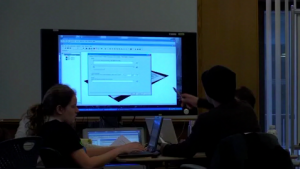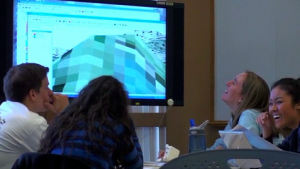I just finished teaching a course that introduces Anthropologists to Geographical Information Systems. Labs form a part of many science courses, and this is not different in my class. What may be different is that I make the labs part of the class instead of part of the homework. And probably quite different is that the labs are being worked on collaboratively.
What made this project possible is a newly designed Academic Computing classroom in Meyer 220, called Flex Class. The goal of the Flex Class is to support collaborative pedagogies that integrate the use of large- and small-group shared displays and collaborative software in an environment that maximizes ease of use and minimizes on-demand support (McCullough 2009).
This is an example of what we often see in a traditional lab setting.

January 29, 2010 by vancouverfilmschool (CC)
This is how it looks like in my class.
So what makes the difference? Here are a few observations. First of all, I am tapping into the pool of knowledge of the class as a whole. "If we are stuck as a group we can have other groups look at our screen to help us out", one student commented. Secondly, students are actively engaged. Instead of presenting me with basic how-to questions students often had discussed various solutions in the group before bringing me in to comment and questions tended to go deeper into the background of the material. Thirdly, students enjoy what they do. Asked how much they enjoyed learning in this classroom compared to a regular classroom on campus, 85.7% of the students stated "Very much" and the remaining stated "Quite a bit". And lastly, it was more evident than in prior iterations of this class, how lab content informed the students' final projects and improved their quality.
Collaboration also might help against cheating. From Jeffrey R. Young in CHE: "Mr. Pritchard, the MIT professor, did find a way to greatly reduce cheating on homework in his classes. He switched to a "studio" model of teaching, in which students sit in small groups working through tutorials on computers while professors and teaching assistants roam the room answering questions, rather than a traditional lecture."
Acknowledgments:
This project depended, of course, highly on collaboration. I am indebted to my colleagues Beth McCullough, Alex Schorsch, Surajit Bose, Dustin King, Kim Hayworth, Helen Chen, and the students of my class for their enthusiasm and critique.

